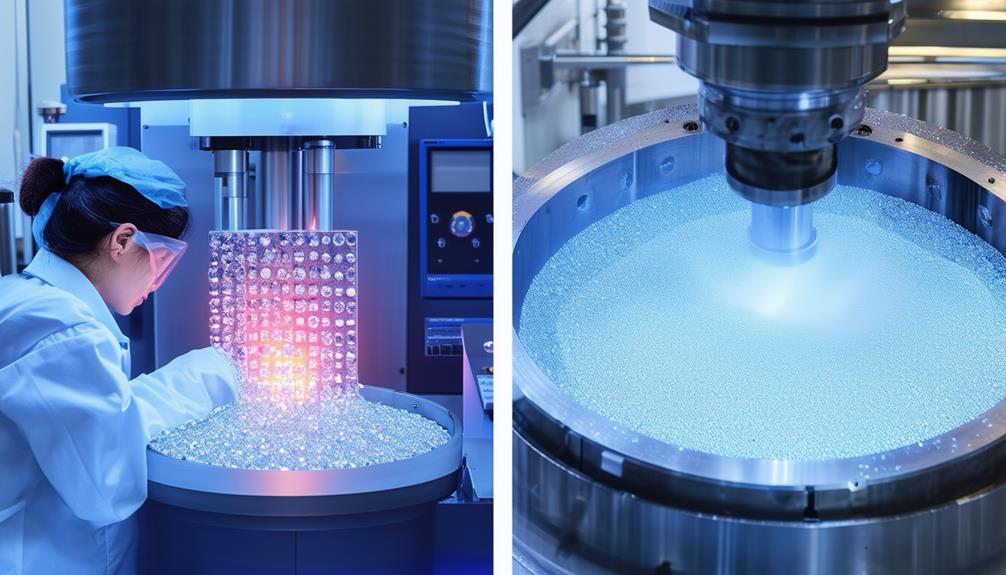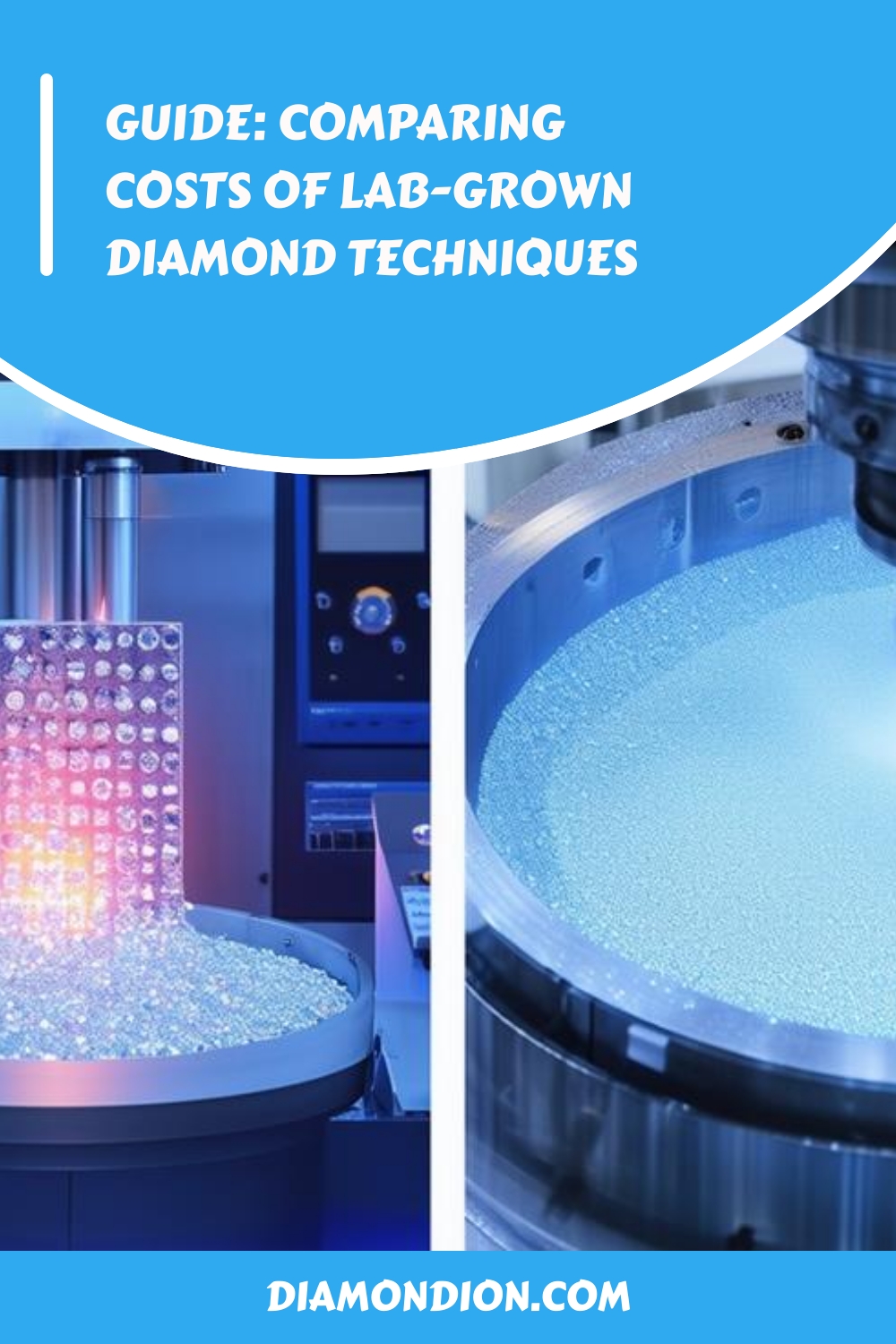Article Contents
In analysing the costs associated with lab-grown diamonds, the High Pressure High Temperature (HPHT) and Chemical Vapor Deposition (CVD) methods exhibit different cost structures.
The HPHT method, known for producing diamonds with high clarity and customisable colours, requires substantial energy, which increases production costs.
On the other hand, the CVD method is more energy-efficient, leading to lower operational costs and a smaller environmental footprint. This efficiency not only saves resources but also addresses some ethical issues associated with traditional diamond mining.
Market trends show that the reduced costs of CVD have led to lower prices for lab-grown diamonds, making them more accessible and appealing in the market. Further research can provide deeper insights into how each method influences overall costs.
Key Points
- The high-energy requirements of HPHT (High Pressure High Temperature) diamond synthesis result in greater production costs compared to those of CVD (Chemical Vapor Deposition) diamonds, which utilise a more energy-efficient process.
- Due to its lower energy consumption, CVD technology not only reduces operational expenses but also lessens environmental impact.
- A decline in the prices of lab-grown diamonds has been observed, indicating enhancements in both HPHT and CVD production technologies.
- Lab-grown diamonds, produced using either HPHT or CVD methods, are typically priced between 70% and 85% lower than their natural counterparts, primarily due to more economical manufacturing processes.
- Lab-grown diamonds that are certified, regardless of the production technique used, tend to achieve higher prices in the market as certification assures quality and authenticity.
Understanding HPHT Diamonds
HPHT diamonds are artificially created through a process that imitates the natural conditions below the Earth's surface, involving high pressure and temperature. This method not only mimics the environment where natural diamonds are formed but also improves their quality, offering high clarity and the option for colour customisation. In this process, a small diamond seed is placed in an advanced growth chamber, where it undergoes transformation under controlled conditions, evolving from a basic form into a polished, high-quality gem.
The unique aspect of HPHT technology is its ability to change the colour of diamonds, which may naturally have yellow or brown hues due to nitrogen impurities. By adjusting these colours, HPHT can reduce unwanted tones or introduce preferred ones, giving consumers the choice to customise their diamonds according to personal preferences. This capability to tailor the appearance of diamonds makes HPHT an attractive option for those looking for both distinct beauty and personalised luxury in their jewellery.
Exploring CVD Diamonds
While HPHT diamonds are customisable in terms of colour and clarity, Chemical Vapor Deposition (CVD) diamonds offer a technologically advanced alternative with similar properties and significant environmental advantages. The CVD process occurs in sophisticated lab settings where gases facilitate the growth of diamonds on a substrate, mimicking natural formation but with enhanced control and reduced environmental impact.
This method conserves natural resources and avoids the ethical issues linked to traditional diamond mining. CVD diamonds are precisely cultivated, allowing customisation of characteristics like carat, colour, and clarity, free from the geographical and ethical limitations of mining.
The growing appeal of CVD diamonds lies in their quality, ethical production, and cost-effectiveness. Controlled lab conditions enable the tailoring of the diamond growth process, ensuring each gem meets high standards of excellence. This offers consumers a luxury product that is both ethically sourced and sustainable, reflecting contemporary values of environmental responsibility and ethical consumption. These lab-grown diamonds exemplify a significant advancement in sustainable luxury, promoting responsible use of our planet's resources.
Energy Costs in Diamond Production
Energy costs have a major impact on the production of lab-grown diamonds, especially when looking at the High-Pressure High-Temperature (HPHT) and Chemical Vapor Deposition (CVD) methods. The HPHT method, which is a traditional approach, requires a significant amount of energy because of the high pressure and temperature needed to replicate the natural conditions in which diamonds are formed. This high energy usage leads to higher production expenses and has a greater environmental impact.
On the other hand, the CVD method is more energy-efficient. Although it still requires specialised equipment, the energy needed to maintain operational conditions is much lower compared to HPHT. This efficiency not only reduces production costs but also minimises the environmental impact, making CVD a more environmentally sustainable option for diamond production.
These differences are important for stakeholders who take into account both economic and environmental considerations. The superior energy efficiency of CVD increases its attractiveness as a more environmentally and economically viable method for producing synthetic diamonds. This assessment highlights the significance of technological advancements in reducing operational expenses and promoting sustainability in the gemstone industry.
Market Pricing Trends
Market pricing trends for lab-grown diamonds have significantly decreased, enhancing their accessibility to consumers. Notably, prices have dropped by 30% over the past year and by 50% over the past two years, highlighting a trend influenced by both increased production efficiency and a growing consumer preference for sustainable products. This price reduction has broadened their market appeal, aligning with global values of economic and environmental sustainability.
Lab-grown diamonds are now priced 70-85% lower than natural diamonds. This pricing reflects not only technological advancements but also competitive dynamics within the industry. As consumer demand for ethically produced and cost-effective alternatives rises, the market responds accordingly, similar to historical trends observed with lab-grown emeralds.
The table below summarises the recent pricing trends:
| Year Comparison | Price Reduction (%) |
|---|---|
| Past 1 Year | 30 |
| Past 2 Years | 50 |
| Relative to Natural Diamonds | 70-85 |
These trends underscore a shift towards lab-grown diamonds, driven by consumer preferences for affordability and ethical responsibility.
Certification and Value Impact
Certification from esteemed gemological institutions significantly enhances the perceived value and marketability of lab-grown diamonds. As consumers increasingly value certified products for guaranteed quality, the impact of such certifications on market demand is evident. When lab-grown diamonds are certified by reputable entities like GIA, IGI, or HRD Antwerp, they not only authenticate the diamonds' quality but also elevate their position in the jewellery market, often commanding higher prices.
- Quality Assurance: Certifications verify the gem's stated attributes, instilling confidence in both buyers and sellers.
- Resale Viability: Diamonds with certifications typically achieve higher resale values and are more easily accepted in the market.
- Consumer Trust: A certificate from a recognised lab boosts consumer confidence, encouraging the purchase of lab-grown diamonds.
- Market Differentiation: Certification sets these diamonds apart in a competitive market, highlighting their quality and craftsmanship.
- Investment Appeal: Certified lab-grown diamonds are more appealing to investors and collectors, aligning with market trends and consumer preferences.
As the industry advances, the role of certification in shaping the lab-grown diamond market becomes increasingly crucial, impacting not just consumer choices but also the overall dynamics of the jewellery market.
Frequently Asked Questions
How do lab-grown diamonds compare in price?
Lab-grown diamonds typically cost 30-40% less than their natural counterparts, allowing savings of up to 60-70%. This price difference makes them an appealing choice for consumers who value affordability and ethical considerations.
Which Method of Lab Grown Diamond Is Better?
The choice between methods for producing lab-grown diamonds largely depends on the specific priorities of the buyer or manufacturer. Chemical Vapor Deposition (CVD) is noted for its faster production times and reduced environmental footprint, making it more appealing for those who prioritise efficiency and environmental sustainability. This method aligns with values of responsible consumption and ethical production practices.
What is the true cost of a lab-grown diamond?
The true cost of a lab-grown diamond takes into account not only economic affordability but also includes significant environmental benefits and the ability to scale production efficiently. These factors make lab-grown diamonds a sustainable and valuable choice for environmentally conscious consumers.
What should I pay for a lab-grown diamond?
When determining the price of a lab-grown diamond, take into account factors like the diamond's cut, clarity, and carat weight. Remember that although these diamonds provide a cheaper alternative to natural diamonds, their resale value is usually lower.
Conclusion
In the diverse world of gemstones, lab-grown diamonds introduced through High Pressure High Temperature (HPHT) and Chemical Vapor Deposition (CVD) methods offer sustainable and cost-effective alternatives. These technologies differ in their cost implications and energy requirements.
Certified lab-grown diamonds match the aesthetic qualities of naturally mined diamonds and offer an ethical advantage, making them an increasingly popular option in contemporary jewellery design.



